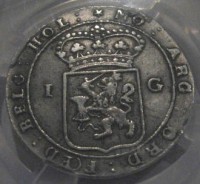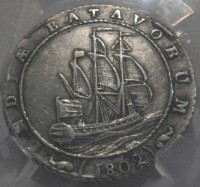
Stage One - Unwanted Foundations of a New, Evolving People
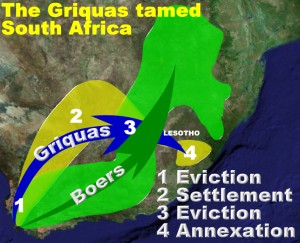
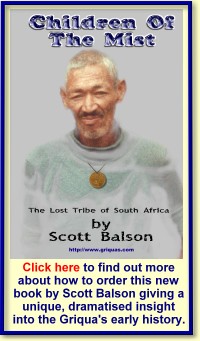 Children
of the Mist - S Balson (BUY ONLINE NOW!!)
Children
of the Mist - S Balson (BUY ONLINE NOW!!)
Email: info@tokencoins.com
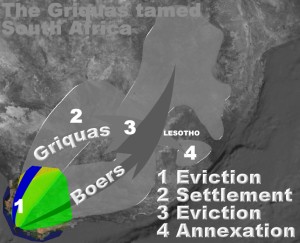
The Khoikhoi people in the Cape originated from the northern parts of Botswana, migrating south and settling near the Vaal river around the time of the birth of Christ bringing with them their herds of cattle and sheep that they had earlier secured from natives in East Africa. About 200AD the people in this large community had a major disagreement. The Korana stayed in the middle part of South Africa while the other two clans moved away, the Namaqua settling in Namaqualand to the west and the Khoikhoi moving south then west to the Cape of Good Hope. By the time the first white explorers passed the Cape of Storms the Khoikhoi had intermarried with the hunter-gatherer San (Bushmen) who were the region's original inhabitants. Over generations the difference between the two groups became less defined but the Khoikhoi continued to graze livestock and the San continued to hunt with bows and poisoned arrows.
Image right: the Khoi-Khoi and Bastards were continually evicted from their homes
It is important to note that the Griqua nation, largely founded on the Khoikhoi
(men of men - also known as Khoekhoen or Hottentots), were pastoral
people who lived a laid back life at one with nature and their surrroundings.
Their lifestyle would have been seen as slothful and lazy by westerners,
and was, as you will read in the commentary below and elsewhere on this website
by settlers, explorers and missionaries when describing their off-spring.
This perspective of their life, while quoted from contemporary books to support
facts, is sadly misplaced if one takes into account their perfect
"lazy" lifestyle that had evolved over thousands of years through their
traditional pastoral culture in the Cape. Their "richness" was their
community-based culture, lost to western civilisation today. The Hottentots,
basked in the sun, passed down their interpretation of philosophy and history
through gifted story telling in a land in which they had few natural enemies.
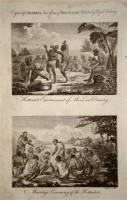
But that was before the whiteman came and imposed himself and his greed-based culture on them.
After all:
Who needed nobility, who needed power, who needed pride?
The Khoi-Khoi had no need to pout they had life in their stride.
Perfect they were, evolving from centuries of life on the roam
That was until white man came and stole their heavenly home.
Scott Balson
A clear pointer to the inaccuracies and bias of early reports by explorers
is this copy of the original antique copper engraved graphic page from
Bankes Geography (1790) entitled Hottentot Entertainment of Music
and Dancing & Marriage Ceremony of the Hottentots.
You will notice (click on image right) that the Hottentots resemble Europeans
except for their traditional clothing and curly hair! The artist had no idea
what the Hottentots looked like! (Image from the Balson Holdings Family
Trust)
| Hemmy Gysbert
in his Latin oration delivered
to the Hamburg Academy on 10th April 1767 describes the Hottentots
thus,
This race of men has a good physique, is swift of foot, and averse to hard labour: the majority of them succumb to old age, except those who fall victim to weapons or wild beasts. In colour they are dark rather than black. They are tall and thin, yet so powerful they can withstand the charge of an ox in full career. Their eyes are beautiful but watery, their noses flattened, their breath foul-smelling. Their teeth are ivory white. Their fingers are equipped with little talons, like the claws of eagles. They have graceful ankles and small feet. Their hair is like wool and adorned with pendants or coral` and numerous types of trinkets, made of lead, copper or brass. The great majority of them go about naked or wearing sheepskins they call "Krossen", and which they wear instead of clothing, their private parts they cover with a loin cloth, known as the Kul-Kross. The woman have pendulous breasts, which they can throw over their shoulders and offer to their babies. The chief ornaments of the women are in the form of beads. To protect themselves against the heat of the sun they anoint their faces and bodies with an unguent made of animal fat, butter and soot. Some of them live off the raw flesh of animals, the rest eat it half-cooked, dragging the flesh through their teeth. Three hand coloured images from the 1700s "of the Hottentot" - the images, like many from these earliest reports, are grossly inaccurate bearing no resemblance to the Khoi (Hottentot). (Plates from Modern History or the Present State of All Nations, Describing Their Respective Situations, Persons, Habits and Buildings, Manners, Laws and Customs, Plants, Animals and Minerals by Salmon, Thomas. c1735.) |
Before the whiteman came small families of Hottentots lived happily in tight-knit villages throughout the area now known as Cape Town. In 1652 Van Riebeeck and the first settlers used western logic to acquire the land that the Dutch East India Company (Vereenigde Oost-indische Compagnie or VOC) wanted as a staging post for passing ships. Within years the Hottentots had been displaced as they realised that the Dutch were unlike any antagonists they had faced before. The Dutch were there to stay and were establishing a more permanent hold when they started building the distinctive looking Fort with its incredibly thick walls. The Khoi Khoi fought two wars with the Dutch, and, had they persisted, they probably would have pushed them back into the sea. Unfortunately, they treated the Dutch like other native tribes, and just stole their cattle, thinking that this loss would drive them away. They had no way of knowing the power behind the enterprise backing up the Dutch sailors who visited their shores and started occupying their lands.
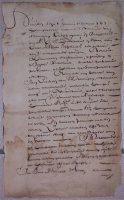
Image right: One of the very first land grant issued at the Cape of Good Hope (COGH), dated the 6th January 1677 (just 12 years after the first settlers arrived at the COGH in 1665). This manuscript document issued by van Banitan (see below), as Secretary is also signed by two members of the Council of Policy. This grant consists of two back to back pages with a watermark of the Dutch East Company (VOC). This land had been confiscated from the Hottentots in Cape Town not long before. There were no revenues on this document as the VOC Directorate had made a decision not to allocate land to officials of the company. However by the time Wilhem van der Stel arrived to take up his post as Govenor of the COGH he found that most key officials owned the land on which they farmed contrary to the VOC directorate's policy and had been corruptly issued with land grants, the new landowner often been an official party to the document. More early and interesting title deeds in the Balson Holdings Family Trust can be seen at this link. This very rare document is owned by the Balson Holdings Family Trust Take this link to see the VOC Commanders and Governors of the Cape of Good Hope to 1795 |
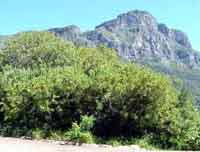
As white land ownership was extended beyond Cape Town a physical barrier was erected by the Dutch East India Company (VOC) to keep the thieving Hottentots away from the growing settlement. This barrier is still marked by the remains of the historic 350 year old van Riebeek's Hedge consisting of wild Hottentot almond (Brabejum stellatifolium) that sprawls through part of Kirstenbosch Gardens (see image right).
William Rhyne, a Member of the Council of Justice of the Dutch East India Company travelled to the Cape in October 1673 and recorded the manner of their living, which he found to be barbaric when compared with that of the white conquerors.
In 1713 things became worse, much worse for the Hottentots as a major outbreak of smallpox brought into the community of the Cape by the settlers and passing sailors devastated their population reportedly wiping out complete Hottentot tribes.
Image
right: Map of the Cape of Good Hope (Saldanha Bay to False Bay) published
in early 1700s by well known cartologist Guillaume de L'isle (1675-1726 from
Venice) held in the Balson Holdings Family Trust.  The map (click on image
right) shows Hottentot villages (origins of the the Griqua people) present
in this area at the time of the first white
settlement. (More about the map at this link)
The map (click on image
right) shows Hottentot villages (origins of the the Griqua people) present
in this area at the time of the first white
settlement. (More about the map at this link)
These first inhabitants in the Cape, the Hottentots, and their coloured offspring were the foundation of the Griqua people born out of generations of shame. The raiding by the first Dutch settlers of the Hottentot cattle and sheep herds caused conflict from the earliest days, this was followed by the oppressive state of serfdom then slavery that the Hottentots found themselves being forced to endure across the colony. Rhyne's view of the blacks as "barbaric" prevailed among the growing white community who plundered the Hottentot's herds, took their lands and their freedom.
Campbell, in his first trip to South
Africa records on page 329 how the Hottentot lands were typically
stolen by the settlers. Campbell came across a small Hottentot kraal in 1813
just within the north-western frontier of the Cape Colony,
"where we would have halted for the night, but their
fountains were dried up, so that they had no water for man or beast, and
were to remove from it in the morrow. From their account they had once had
a better place, but a boor, having asked permission first to sow a little
corn, then to erect a mill, they allowed it; after which he applied to Government
for a land grant of the whole place, which they promised not knowing that
it was in possession of these Hottentots; of course they were then driven
from
it".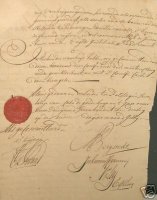
Image right: Cape of Good Hope Land Grant - dated 10th July 1730 - more about this and other rare land grants in the Balson Holdings Family Trust at this link
The cohabitation of white male farmers with female Hottentot slaves on remote farms across the Cape colony dramatically expanded the number of Bastards - so named because of their mixed blood. In fact Theal records that 75% of children born to Hottentot women in the 1700s were as a result of a union whith a white settler. This new multiracial people saw themselves as better than other natives and Hottentots (source White supremacy and black resistance in pre-industrial South Africa) and from the earliest days joined the white settlers in their raiding parties beyond the borders of the colony - learning a depth of savagery for which they alone would be later derided.
| Yaqub Paul Murray reflects about his (coloured) Griqua
heritage... saying
(full article
here):
Ma (as she was universally titled in the Hendricks family) was born in Sutherland, in the Karoo at the turn of the 20th century. Her father, my great-grandfather, was a Boer, a sheep farmer. He had an Afrikaner family by day, and he had my dark-skinned great-grandmother in the shadows of a Karoo night in a clandestine and profoundly illicit relationship. My grandmother was born within the yoke of this colonial relationship. While her mother was probably an indentured servant on the Van Rhyn farm, a status all but synonymous with that of a ‘slave’. When the old Boer died, his White sons, my grandmother’s half-brothers, forced her from the farm. She was in her teens. Arriving in an urban Cape Town, she did domestic work for a Jewish family and somehow met Robert Hendricks, who seemingly was not racist. |
Large numbers of this evolving group of outcast Bastards and indigenous people became "troublesome" and were expelled from the Cape of Good Hope after having their traditional lands stolen from them under white man's laws. They were expelled together with law breaking white settlers who joined them in lands away from the colony's influence. Roving gangs of Bastards on horseback, known as the Bergenaars, started raiding native tribes further inland and pillaging their herds - even reaching the Orange river which they crossed before they settled at places like Hardcastle. From these earliest times the Bastards were led by the Kok family.
Image right: Hardcastle - first settlement north of the Orange River
The Bastards were at this time a truely multiracial tribe made up of thieves, heroes, hunters, Missionaries, coloureds, Hottentots, Bushmen, blacks, giants as well as whites and no-hopers escaping the long arm of the law in the Cape. As a result they were, as a group, always in trouble with the settlers who continued to extend their sphere of influence, using white man's rules to drive them further and further afield.
The Griquas are a subset of the derogatorily named Bastard (coloured) people under Adam Kok and Barend Barends. The Bastards (coloureds) continued to be so named right into the 19th Century. It was these first "Bastards" who were the true voortrekkers of the region north of the Orange river. They were typical frontiersmen, not unlike the boers who followed them. They disliked agriculture, loved wandering and lived entirely on milk and meat. They did not take title to the vast lands because it was theirs - no one else wanted possession of the land at that time.
In 1795 the British took over control of the Cape colony from the VOC as bounty during the Napoleonic wars of 1795-1815. (The French occupying the Dutch territories in Europe from 1795).
In about 1800 the "bastards" first moved north of the Orange River and settled at a place they called Hardcastle because of its backdrop of large rocky walls running either side of a narrow gorge through which a spring ran. Here they could find some protection from the vast herds of game and predators that ruled the region. The location of Hardcastle was first identified by Scott Balson in 2007 during his book tour. More in the video clip below. The Griqua later moved about 30 km north to a location first called Klaarwater but later renamed Griquatown.
The Batavian Guilder
While the Bastards had left behind their homeland in the Cape the Dutch government, following the financial collapse of the Dutch East India Company, issued the silver gulden coins for circulation across all their claimed territories from South Africa to India to modern day Indonesia.
It has been suggested from time to time that these coins were South Africa's first indigenous coinage. This is a ridiculous claim as they were issued in the Netherlands for circulation across their seafaring route. The coins were used by their own sailors across the entire trade route and played no real role in ports like Cape Town and were certainly not used by the indigenous population.
An example of the Batavian Gulden in the Balson Holdings Family Trust can be seen below.
